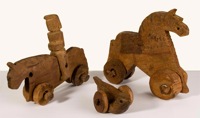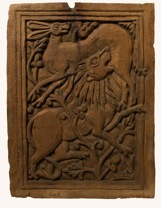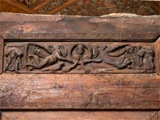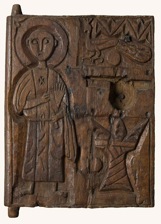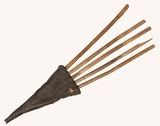Inv. No. 7211
Tamarisk wood
H: 20 cm, W: 95.5 cm
Unknown provenance, 6th century
The depiction of Nilotic elements goes back as far as Pharaonic times. A rich variety of animals and plants enliven the riverbanks. This frieze was decoratively set into the walls of architectural structures. It shows a well-fed crocodile surrounded by fish and various blossoms, a wine leaf and other plants.
Toys
Inv. Nos. a) 8894 (horse), b) 8895 (man on horseback), c) 8890 (bird)
Wood
H: a) 16 cm, b) 15 cm, c) 4.5 cm
L: a) 17.5 cm, b) 19 cm, c) 10.3 cm
a) Karanis (Kum Aushim), b) Oxyrhynchos, c) Gerzeh, 5th-7th century
These three wooden toys are among the best preserved examples discovered in late Antique children’s burials or settlement sites. The toys were pulled by a string attached through a hole in the animal’s head or neck. The horse retains faint traces of green and red colour.
Panel with relief
Inv. No. 10519
Wood
H: 35.2 cm, W: 26,3 cm
Aphroditopolis (Kom Ishqaw), 6th / 7th century
This relief was originally part of a wooden box and is among the finest pieces retained from late Antique remains in Aphroditopolis. It shows a lion attacking an antelope within a fruitbearing plant.
Lintel
Inv. No. 753
Sycamore wood
H: 36 cm, W: 274 cm
Old Cairo, presumably from the Hanging Church (el-Mo’allaqa), 5th century
This exceptional lintel depicts two scenes from the New Testament: The entry of Jesus, as a king, into Jerusalem and the Ascension. In the first scene (on the left) Jesus is entering the city on a donkey. There are three figures opposite of him: one is spreading his cloak before Christ. Another is praising Jesus by waving with a palm-branch and the dancing daughter of Zion (John 12:15) turns her head back to the second scene. Jesus is enthroned in a Mandorla supported by angels in full flight and two animals associated with the evangelists, the ox (Luke) and lion (Mark). Jesus is flanked by Virgin Mary (next to him on the left side) and the apostles. Above these two scenes a hymn in four Greek lines is praising Jesus.
Altar
Inv. No. 1172
Pine wood
H: 100 cm, W: 120 cm, D: 75 cm
Old Cairo, Church of Sts. Sergius and Bacchus, 5th century
The church of Sts. Sergius and Bacchus once kept the oldest wooden altar discovered in Egypt. Today the altar is displayed next door at the Coptic Museum. All four sides imitate arcades with torsated columns and Corinthian capitals. The panels above them are decorated with shells and crosses, as well as foliage and birds. Originally there were four columns on the long sides and two columns on the short sides of the altar, only eight columns are preserved.
Door with two leaves
Inv. No. 738
Sycamore and pine wood
H: 240 cm, W: 107 cm
Old Cairo, Church of St. Barbara, 6th century
This door with two leaves is the most remarkable and best preserved example among a few doors recovered from the Roman and Byzantine periods. It was discovered between two walls during restoration works in the church of St. Barbara. Despite considerable damages, the artistic skill of its producers can still be noticed. On the front of the door (left leaf) a panel at the upper corner is decorated with the bust of Jesus Christ within a wreath supported by two angels. The scene is flanked by two saints set against curtains and holding the holy book. The back of the door is richly carved with vine-scrolls, vine-leaves and grapes growing out of vases.

Inv. No. 1175
Wood
Hanging Church (el-Mo’allaqa), Fatimid Period
This wooden altar cupola is decorated with Greek crosses and interlaces foliage in relief. There are also traces of painted figures and ornamentation in the center of the panels.
Panel with relief
Inv. No. 8796
Wood
H: 29 cm, W: 22.5-25 cm
Bawit, Monastery of St. Apollo, cell 41, 6th / 7th century
Due to the tenons at the upper left and lower edges, this panel originally functioned as the lid of a box or door of a cupboard. The monk is depicted as a scribe with a conically-shaped pen-case hanging over his left shoulder (cf. leather case inv. no. 9223). In his left hand he is holding a scroll. A peacock in the upper right corner symbolizes resurrection. At the bottom on the right is a horned altar.
Leather case
Inv. No. 9223
Unknown provenance, Byzantine Period
Leather case in conical shape with five tubules into which the pens were slipped.

